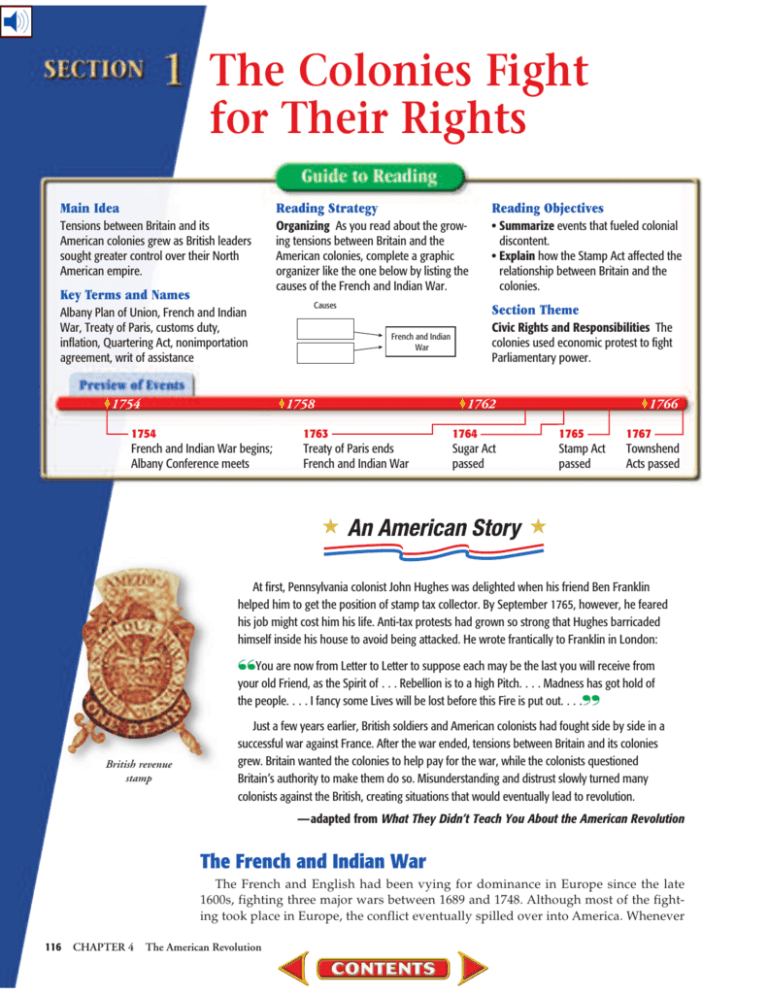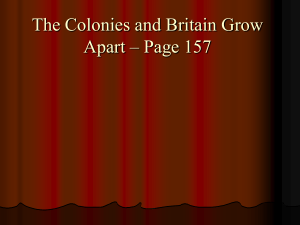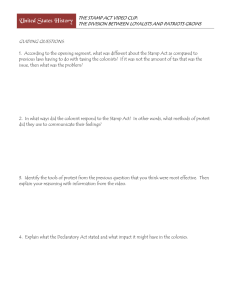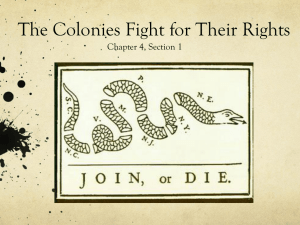The Colonies Fight for Their Rights
advertisement

The Colonies Fight for Their Rights Main Idea Reading Strategy Reading Objectives Tensions between Britain and its American colonies grew as British leaders sought greater control over their North American empire. Organizing As you read about the growing tensions between Britain and the American colonies, complete a graphic organizer like the one below by listing the causes of the French and Indian War. • Summarize events that fueled colonial discontent. • Explain how the Stamp Act affected the relationship between Britain and the colonies. Key Terms and Names Albany Plan of Union, French and Indian War, Treaty of Paris, customs duty, inflation, Quartering Act, nonimportation agreement, writ of assistance ✦1754 Causes Section Theme French and Indian War ✦1758 1754 French and Indian War begins; Albany Conference meets 1763 Treaty of Paris ends French and Indian War Civic Rights and Responsibilities The colonies used economic protest to fight Parliamentary power. ✦1762 1764 Sugar Act passed ✦1766 1765 Stamp Act passed 1767 Townshend Acts passed At first, Pennsylvania colonist John Hughes was delighted when his friend Ben Franklin helped him to get the position of stamp tax collector. By September 1765, however, he feared his job might cost him his life. Anti-tax protests had grown so strong that Hughes barricaded himself inside his house to avoid being attacked. He wrote frantically to Franklin in London: You are now from Letter to Letter to suppose each may be the last you will receive from “ your old Friend, as the Spirit of . . . Rebellion is to a high Pitch. . . . Madness has got hold of the people. . . . I fancy some Lives will be lost before this Fire is put out. . . . ” British revenue stamp Just a few years earlier, British soldiers and American colonists had fought side by side in a successful war against France. After the war ended, tensions between Britain and its colonies grew. Britain wanted the colonies to help pay for the war, while the colonists questioned Britain’s authority to make them do so. Misunderstanding and distrust slowly turned many colonists against the British, creating situations that would eventually lead to revolution. —adapted from What They Didn’t Teach You About the American Revolution The French and Indian War The French and English had been vying for dominance in Europe since the late 1600s, fighting three major wars between 1689 and 1748. Although most of the fighting took place in Europe, the conflict eventually spilled over into America. Whenever 116 CHAPTER 4 The American Revolution France and England were at war, their colonies went to war as well. In 1754 a fourth struggle began. The First Skirmish In the 1740s, the British and French both became interested in the Ohio River valley. The French had discovered that they could cross from Lake Ontario to the Ohio River in western Pennsylvania and follow the river south to the Mississippi. This allowed the French to travel from New France to Louisiana easily. At the same time, British fur traders entered the region, and land speculators—people who bought empty land hoping to sell it to settlers for a profit—became interested in the Ohio River valley. To block British claims in the region, New France’s governor, the Marquis Duquesne, ordered a chain of French forts to be built from Lake Ontario to the Ohio River. Duquesne’s actions prompted Robert Dinwiddie, the governor of Virginia, to order a British fort built in western Pennsylvania. Before the British fort was completed, the French seized it and built Fort Duquesne at the site. Dinwiddie then asked George Washington, a young officer in the Virginia militia, to raise a force and expel the French. As Washington’s troops marched toward the Ohio River in the spring of 1754, they encountered a small French force near Great Meadows. After a brief battle, Washington retreated and built a stockade named Fort Necessity. A little over a month later, a large French force arrived and forced Washington to surrender. After being released, Washington returned to Virginia, leaving the French in control of the Ohio River valley. As the fighting between France and Britain expanded into a world war, the 22-year-old Washington became a hero in the colonies for his courageous attempt to resist the French. remain neutral. The colonies also agreed that Britain should appoint one supreme commander of all British troops in the colonies. Finally, the conference issued the Albany Plan of Union, a scheme developed by a committee led by Benjamin Franklin. The Plan of Union proposed that the colonies unite to form a federal government. Although the colonies rejected the Plan of Union, the effort showed that many colonial leaders had begun to think about joining their colonies together for their common defense. The British Triumph In 1755 the new British commander in chief, General Edward Braddock, arrived in Virginia with 1,400 British troops. He linked up with 450 local militia troops and appointed Lieutenant Colonel George Washington to serve as his aide. Braddock then headed west intending to attack Fort Duquesne. The general was not worried about being ambushed by the Huron and other Native American allies of the French. “These savages may indeed be a formidable enemy to your raw American militia,” he told Benjamin Franklin. “Upon the King’s regular and disciplined troops, it is impossible they should make any impression.” Seven miles from Fort Duquesne, French and Native American forces did ambush Braddock’s troops. Braddock was shot and later died. His inexperienced troops panicked. Only George Washington’s leadership saved the British from disaster. As shots whizzed past him—four holes were later found in his The Albany Conference Even before fighting started in the Ohio River valley, the British government urged its colonies to work together to prepare for the coming war. The government also suggested that the colonies negotiate an alliance with the Iroquois. The Iroquois controlled western New York—territory the French had to pass through to reach the Ohio River. In response, 7 colonies sent representatives to meet with 150 Iroquois leaders at Albany, New York, in June 1754. This meeting became known as the Albany Conference. The Albany Conference achieved several things. Although the Iroquois refused an alliance with the British, they did agree to Analyzing Political Cartoons Appeal for Unity In 1754, as French and Native American forces were threatening the colonies, Ben Franklin drew this cartoon urging colonists to stand together. A popular legend at the time said a snake could put itself back together and live if it did so before sunset. Why did Franklin’s use of the serpent legend make his appeal for unity seem urgent? CHAPTER 4 The American Revolution 117 hat and clothes—Washington rallied the troops and organized a retreat. The ambush had further consequences. Having seen that the British could be beaten, the Delaware people of western Pennsylvania began attacking British settlers in their territory. For the next two years, the French and Indian War raged along the frontier, as both sides raided each other’s territory. Then, in 1756, the fighting between Britain and France spread to Europe, where it later became known as the Seven Years’ War. While Britain’s allies fought the French in Europe, British Prime Minister William Pitt decided to send most of Britain’s troops and fleet to North America and India to attack the French and seize their empire. The British fleet quickly cut off the flow of supplies and reinforcements France had been sending to North America. In the meantime, the Iroquois, realizing the tide had turned in favor of the British, pressured the Delaware to end their attacks. With their Native American allies giving up the battle, the French found themselves badly outnumbered. In 1758 General John Forbes, the new British commander in the colonies, sent troops to attack Fort Duquesne. Realizing they were outnumbered, the French burned the fort and retreated. The British built Fort Pitt, named after the prime minister, on the same site. Fort Pitt eventually became the city of Pittsburgh. In 1759 a British fleet commanded by General James Wolfe sailed up the St. Lawrence River to Quebec City. Wolfe discovered a path from the river up the steep cliffs that protected the city. On September 12, 1759, as his troops marched onto the Plains of Abraham near the city, the French under General Louis Joseph Montcalm attacked. Both Wolfe and Montcalm were killed, and the British won the battle. Fighting continued elsewhere in the world until 1763, but the British victory at Quebec was the turning point in North America. After Spain entered the war in 1761 on the side of France, Britain seized Spain’s colonies in Cuba and the Philippines. The Treaty of Paris finally ended the war in 1763. Except for a few offshore islands, the treaty eliminated French power in North America. New France became part of the British Empire, as did all of Louisiana east of the Mississippi except for History Through Art Fatal Meeting The Battle of Quebec in 1759 was one of Britain’s most dramatic victories over the French during the French and Indian War. Both commanding generals, the French Montcalm and the British Wolfe, were killed on the Plains of Abraham, the bluffs above the St. Lawrence River. What did the Treaty of Paris stipulate about the status of New France? 118 CHAPTER 4 The American Revolution New Orleans. To get Cuba and the Philippines back, Spain gave Florida to Britain. To compensate Spain for its losses, the French signed a separate treaty giving Spain control of New Orleans and all of Louisiana west of the Mississippi. The Proclamation of 1763 HU DS PAN OM O N ' S B AY C Y MAINE QUEBEC (Part of MASS.) Reading Check Examining Why were the French and the British interested in the Ohio River valley? N.H. MASS. I NS N.Y. M O U N TA The Colonies Grow Discontented The Proclamation Act of 1763 In the spring of 1763, a Native American religious leader known as the Delaware Prophet convinced Pontiac, chief of the Ottawa people, to go to war against the British. After uniting several Native American groups, including the Ottawa, Delaware, Shawnee, and Seneca peoples, Pontiac’s forces attacked forts along the frontier and burned down several towns before British troops stopped them. Pontiac’s war did not surprise British officials. They had been expecting trouble since 1758, when reports first indicated that settlers were moving into western Pennsylvania in defiance of the colony’s treaty with the region’s Native Americans. British officials did not want to bear the cost of another war. Many officials also owned shares in fur trading companies operating in the region and did not want to disrupt the fur trade. They decided that the best solution was to limit western settlement until new treaties could be negotiated. In early October, King George issued the Royal Proclamation of 1763. The Proclamation drew a line from north to south along the Appalachian Mountains and declared that colonists could not settle west of the line without the British government’s permission. This enraged many farmers and land speculators, who wanted access to the land. Customs Reform At the same time the Royal Proclamation Act was angering western farmers, new British tax policies were disturbing eastern merchants. In 1763 George Grenville became prime minister and MD. C N ATLaNTIC OCEaN HI LOUISIANA 40° DEL. VA. AN INDIAN RESERVE N.C. A APP AL To achieve its victory in 1763, the British government had borrowed an enormous amount of money to pay for the war and was now deeply in debt. Many British officials thought that the colonies should pay for part of the war, especially the cost of stationing British troops in the colonies. The policies Britain adopted to solve its financial problems angered the colonists and set the two sides on a course to confrontation. R.I. CONN. N.J. PA. 70°W S.C. N GA. E W 30°N S WEST EAST FLORIDA FLORIDA 80°W Gulf of Mexico 0 Proclamation line of 1763 Original 13 Colonies 300 miles 300 kilometers 0 Lambert Azimuthal Equal-Area projection Other British Territory Spanish Territory 1. Interpreting Maps What physical barrier follows the approximate boundary set by the Proclamation of 1763? 2. Applying Geography Skills Why do you think colonists wanted to move west of the boundary line? first lord of the Treasury. Grenville had to find a way to reduce Britain’s debt and pay for the 10,000 British troops now stationed in North America. New tax policies emerged from his efforts. Grenville discovered that British customs agents in America were collecting very little money. Obviously, merchants were smuggling goods into and out of the colonies without paying customs duties—taxes on imports and exports. Grenville convinced Parliament to pass a law allowing customs agents to send smugglers to a new vice-admiralty court in Halifax, Nova Scotia. Unlike colonial courts, where the juries were often sympathetic to smugglers, vice-admiralty courts were run by naval officers. These courts had no juries and did not follow British common law, a violation of the traditional English right to a jury of one’s peers. Transporting colonists to distant Nova Scotia also violated their right to a speedy trial. CHAPTER 4 The American Revolution 119 Causes and Effects of Tensions With Britain Causes • • • • • 1764, Sugar Act 1765, Stamp Act 1767, Townshend Acts 1773, Tea Act 1774, Coercive Acts Effects • Colonists protest that their rights have been violated. • Nine colonies hold Stamp Act Congress. • Colonists boycott British goods. • Sons and Daughters of Liberty formed. • Tea dumped into Boston Harbor during the “Boston Tea Party.” • Twelve colonies attend the Continental Congress. Parliament’s efforts to tax the colonists led to growing protests in the colonies. Analyzing Information If you had been a colonist, how would you have reacted to these taxes? Why? Among those arrested for smuggling and tried by the vice-admiralty court was John Hancock. Hancock had made a fortune in the sugar trade, smuggling molasses from French colonies in the Caribbean. Defending Hancock was a young lawyer named John Adams. Adams argued that the use of vice-admiralty courts denied colonists their rights as British citizens: Here is the contrast that stares us in the face. The “ Parliament in one clause guarding the people of the realm, and securing to them the benefit of tryal by the law of the land, and by the next clause depriving all Americans of that privilege. . . . Is there not in this clause a brand of infamy, or degradation or disgrace, fixed upon every American? ” —quoted in America’s History The Sugar Act In addition to strictly enforcing customs duties, Grenville also introduced the American Revenue Act of 1764, better known as the Sugar Act. 120 CHAPTER 4 The American Revolution The act changed the tax rates levied on raw sugar and molasses imported from foreign colonies. It also placed new taxes on silk, wine, coffee, pimento, and indigo. Merchants throughout the colonies complained to Parliament that the Sugar Act hurt trade. Many were also furious that the act violated several traditional English rights. The act specified that merchants accused of smuggling were presumed guilty until proven innocent. The Sugar Act also allowed British officials to seize goods without due process, or proper court procedures, in some circumstances, and prevented lawsuits by merchants whose goods had been improperly seized. Parliament, however, ignored the protests of the merchants. In many colonial cities, pamphlets soon circulated condemning the Sugar Act. One pamphlet, written by James Otis, argued that because the colonists had no representatives in Parliament, they could not be taxed for the purpose of raising money. Parliament had the right to control trade, but taxing Americans to pay for British programs was different. Otis’s arguments gave rise to the popular expression, “No taxation without representation.” Despite the protests, the Sugar Act remained in force, and Grenville pressed ahead with other new policies. To slow inflation, which happens when money loses its value over time, Parliament passed the Currency Act of 1764. This act banned the use of paper money in the colonies, because it tended to lose its value very quickly. The act angered colonial farmers and artisans. They liked paper money precisely because it lost value quickly. They could use paper money to pay back loans, and since the money was not worth as much as when they borrowed it, the loans were easier to pay back. Reading Check Summarizing How did the British government hope to solve its financial problems caused by the cost of the French and Indian War? The Stamp Act Crisis Although the Sugar Act began to bring in money for Britain, Grenville did not believe it would raise enough to pay all of the government’s expenses in America. To raise more money, he asked Parliament to introduce a stamp tax in the American colonies. The Stamp Act passed Parliament in March 1765. The Stamp Act required stamps to be placed on most printed materials, including newspapers, pamphlets, posters, wills, mortgages, deeds, licenses, and even diplomas, dice, and playing cards. The stamp tax was different from other taxes the colonies had paid to Britain. Parliament had imposed many taxes on trade, but the stamp tax was the first direct tax Britain had ever placed on the colonists. With the Stamp Act set to take effect on November 1, 1765, Parliament passed one more law. The Quartering Act forced the colonies to pay more for their own defense. If the colonies did not provide barracks for British troops, the act stated that troops could stay in taverns, inns, vacant buildings, and barns, and the colonies had to pay the rent. As word of the Stamp Act spread through the colonies in the spring of 1765, a huge debate began. A flood of editorials, pamphlets, speeches, and resolutions against the tax swept through the colonies. In Virginia, the House of Burgesses passed a series of resolutions declaring that Virginians were entitled to the rights of British people and could only be taxed by their own representatives. Other colonial assemblies passed similar statements. By the summer of 1765, huge mass meetings and demonstrations were taking place. In Connecticut, a merchant named Isaac Sears organized a group called the Sons of Liberty. The organization grew quickly throughout the colonies. The Sons of Liberty organized outdoor meetings and demonstrations. They also intimidated stamp distributors. In August 1765, for example, a Boston mob hung an effigy of the city’s new stamp distributor from a tree, then pulled his house apart and burned the wood. In Newport, Rhode Island, the wife of a pro-British merchant described a similar protest: In the morning . . . a mob assembled and erected “ a gallows near the town house and then dispers’d, and about ten a clock reassembled and took the effigy’s of [several] men and the Stamp Master . . . to said gallows where they was hung up by the neck. . . . And about five a clock in the afternoon they made a fire under the gallows which consumed the effigy’s, gallows and all. . . . About dusk they all muster’d out again, and . . . broke every window in his house, frames and all, likewise chairs, tables, pictures and everything they cou’d come across. ” —quoted in Eyewitness Accounts of the American Revolution In October 1765, representatives from nine colonies met for what became known as the Stamp Act Congress. Together they issued the Declaration of Rights and Grievances. Drafted by a wealthy farmer from Pennsylvania named John Dickinson, the declaration argued that only the colonists’ political representatives and not Parliament had the right to tax them. The congress then sent a petition to King George asking for relief and to the British Parliament asking for the repeal of the Stamp Act. On November 1 the Stamp Act took effect, but the colonists ignored it. Throughout the colonies, a movement began to boycott all British goods. People substituted sage and sassafras for imported tea. They stopped buying British cloth. In New York, 200 merchants signed a nonimportation agreement, pledging not to buy any British goods until Parliament repealed the Stamp Act. The boycott had a very powerful effect on Britain. Thousands of workers lost their jobs as orders from the colonies were cancelled. British merchants could not collect money the colonies owed them. “The avenues of trade are all shut up,” complained one merchant. “We have no remittances and are at our wits end for want of money. . . .” Popular Protest Past: Colonial Protests In the 1770s, colonial women entered into the spirit of protest, too. They stopped drinking British tea and substituted chocolate or coffee. Sometimes they even gave up buying the ribbons they used to trim their bonnets. The British cartoon above made fun of women protesters in Edenton, North Carolina. Present: World Trade In late 1999, protesters gathered in Seattle, Washington, to protest the World Trade Organization meeting. Established in 1995, the WTO handles trade disputes and enforces agreements on international trade. Protesters objected that large corporations had too much influence in the WTO. They also objected to WTO meetings being held in closed session. Farmers, environmentalists, and labor groups were among the protesters. in History Sam Adams 1722–1803 A passionate defender of colonial rights, Boston’s Sam Adams was either a saint or a scoundrel—depending on who was describing him. His second cousin, John Adams, who would become the nation’s second president, portrayed Sam as a “plain, simple, decent citizen of middling stature, dress, and manners.” Sam’s enemies, however, saw him quite differently. The royal governor of the colony called him “the most dangerous man in Massachusetts.” Adams enjoyed his reputation as a fiery agitator. “Where there is a spark of patriotic fire,” he once declared, “we will enkindle it.” Born in Boston, Adams graduated from Harvard College in 1740. He briefly studied law, worked as a clerk and merchant, and managed a brewery before being elected tax collector for Boston. As tensions with Great Britain increased, Adams, who had a passion for political issues, discovered his true talents: speaking out against British tax laws and organizing resistance against them. He helped organize the Boston chapter of the Sons of Liberty and wrote several political pamphlets that encouraged Americans to rebel against the Bristish. Adams showed particular skill in uniting Bostonians of different social classes. He forged an anti-British alliance of merchants, lawyers, and other members of the social elite with artisans, shopkeepers, and common laborers, all of whom worked together to protest British tax policies. With protests against the Stamp Act mounting in both Britain and America, British lawmakers repealed the act in 1766. To demonstrate its authority over the colonies, however, Parliament also passed the Declaratory Act. This act asserted that Parliament had the power to make laws for the colonies. Reading Check Evaluating How was the Stamp Act different from other taxes Britain imposed on the colonies? The Townshend Acts During the Stamp Act crisis, the financial problems facing the British government had worsened. Protests in Britain had forced Parliament to lower property taxes there, which caused a further drop in revenue. As a result, Charles Townshend, the new Chancellor of the Exchequer, introduced a series of new regulations and taxes in 1767. These came to be called the Townshend Acts. One of the Townshend Acts was the Revenue Act of 1767. This act put new customs duties on glass, lead, 122 CHAPTER 4 The American Revolution paper, paint, and tea imported into the colonies. Violators of the Revenue Act had to face trial in vice-admiralty courts, where they were presumed guilty unless they could prove their innocence. The Townshend Acts, like the Sugar Act, allowed officials to seize private property under certain circumstances without following due process. To assist customs officers in arresting smugglers, the Revenue Act legalized the use of writs of assistance. The writs were general search warrants that enabled customs officers to enter any location to look for evidence of smuggling. Writs had been used before, but in 1760 James Otis had argued in court that they were “instruments of slavery” that violated people’s rights. The issue remained unresolved until the Revenue Act of 1767 declared writs of assistance to be legal. Action and Reaction Not surprisingly, the Townshend Acts infuriated many colonists. During the winter of 1767 and 1768, John Dickinson published a series of essays entitled Letters From a Pennsylvania Farmer. In these essays, Dickinson reasserted that only assemblies elected by the colonists had the right to tax them. In addition, he called on the colonies to become “firmly bound together” to “form one body politic” to resist the Townshend Acts. Less than a month after Dickinson’s first letter appeared, the Massachusetts assembly began organizing resistance against Britain. Among the leaders of this resistance was Sam Adams, cousin of John Adams. In February 1768, Sam Adams, with the help of James Otis, drafted a “circular letter” for the Massachusetts assembly to pass and circulate to other colonies. In the letter, the men pointed out that Townshend’s taxes would be used to pay the salaries of government officials, a power the colonial assemblies then held. By taking this power away, the Townshend Acts would weaken the assemblies, which the colonists elected to control officials appointed by the king. British officials ordered the Massachusetts assembly to withdraw the letter. The assembly refused. Furious, the British government ordered the Massachusetts assembly dissolved. In August 1768, the merchants of Boston and New York responded by signing nonimportation agreements, promising not to import any goods from Britain. Philadelphia’s merchants joined the boycott in March 1769. In May 1769, Virginia’s House of Burgesses passed the Virginia Resolves, stating that only the House had the right to tax Virginians. Under orders from Britain, Virginia’s governor dissolved the House of Burgesses. In response, the leaders of the House of Burgesses—including George Washington, Patrick Henry, and Thomas Jefferson—immediately called the members to a convention. This convention then passed a nonimportation law, blocking the sale of British goods in Virginia. As the boycott spread through the colonies, Americans again stopped drinking British tea or buying British cloth. Women’s groups, calling themselves the Daughters of Liberty, began spinning their own rough cloth, called “homespun.” Wearing homespun became a sign of patriotism. Throughout the colonies, the Sons of Liberty encouraged people to support the boycotts. In 1769 colonial imports from Britain declined sharply from what they had been in 1768. The Boston Massacre In the fall of 1768, as violence against customs officers in Boston increased, Britain dispatched roughly 1,000 troops to the city to maintain order. Bostonians referred to the British troops stationed there as “lobster backs” due to the red coats they wore. Crowds constantly heckled and harassed the troops. On March 5, 1770, a crowd of colonists began taunting and throwing snowballs at a British soldier guarding a customs house. His call for help brought Captain Thomas Preston and a squad of soldiers. In the midst of the tumult, the troops began firing into the crowd. According to accounts, the first colonist to die was a man of African and Native Checking for Understanding 1. Define: customs duty, inflation, nonimportation agreement, writ of assistance. 2. Identify: Albany Plan of Union, French and Indian War, Treaty of Paris, Quartering Act. Reviewing Themes 3. Civic Rights and Responsibilities What argument did the Stamp Act Congress make in protest against the British taxes? History Through Art American Mockery In this cartoon, a funeral procession mourns the repeal of the Stamp Act. Third in line is “Mr. George Stamp, full of grief and despair,” carrying a coffin of his “favorite child, Miss America Stamp,” who “died hard in 1766.” Who do you think George Stamp is supposed to represent? American descent known as both Michael Johnson and Crispus Attucks. When the smoke cleared, three people lay dead, two more would die later, and six others were wounded. The shootings became known as the Boston Massacre. Colonial newspapers portrayed the British as tyrants who were willing to kill people who stood up for their rights. News of the Boston Massacre raced like lightning across the colonies. It might have set off a revolution then and there, but only a few weeks later, news arrived that the British had repealed almost all of the Townshend Acts. Parliament kept one tax—a tax on tea—to uphold its right to tax the colonies. The repeal of the Townshend Acts again brought peace and stability to the colonies, but only temporarily. Reading Check Examining What was stated in the Virginia Resolves passed by Virginia’s House of Burgesses? Critical Thinking 4. Evaluating Why do you think the British were so willing to pass new taxes in the face of colonial opposition? 5. Classifying Use a graphic organizer similar to the one below to list the acts passed by the British Parliament and the colonists’ reactions to the acts. Act Colonists‘ Reactions Analyzing Visuals 6. Examining Art Study the painting of the Battle of the Plains of Abraham on page 118. How were the British able to move their troops up the steep cliffs near the city? Writing About History 7. Persuasive Writing Imagine that you are a member of the Sons of Liberty or the Daughters of Liberty. Write a pamphlet explaining what your group does and urging colonists to join. CHAPTER 4 The American Revolution 123








